In Praise of Dive Watches
A dive watch might seem an odd thing to write an éloge to, especially by someone who barely spends any time in water. However, I think the features that made dive watches great for scuba diving in the 60s and the 70s are exactly those that make them particularly versatile and useful in everyday life today.
- Parimal Satyal, 23 August 2024
I've always been fascinated by watches.
As a kid, I had a white digital watch that was something of a G-Shock clone that I absolutely adored. It felt like having a little computer that I could take everywhere with me. I felt important. In movies from the 90s and 2000s, important people—to a kid, this meant pilots, SWAT teams, spies, secret agents—had important-looking watches on to do important things. By extension, I felt that having a watch meant that I was also doing important things, or could should the need arise. Not to mention that being able to tell the time was also somewhat useful.
Once mobile phones became commonplace much later in life, I, like a lot of people, stopped wearing a watch. After all, there was no real functional need for one. It wasn't until much later in life, in my early 30s, surely thanks to a YouTube video about the iconic square Casio G-Shock, that I rediscovered watches. And it wasn't until the end of last year that I discovered dive watches.
I'm now convinced that the dive watch is, especially outside of its historical aquatic context, one of the most useful tools you can have on you. And a lot of them are beautiful, too.
What is a dive watch?
When I say "dive watch", I am not referring to modern dive computers that you strap around your wrist when you go scuba diving. No, I'm referring to analog watches that were designed as reliable, robust and legible timing devices that were designed for scuba divers in the 50s and 60s, before dive computers went on to replace them. This style of watch has a few defining characteristics:
- A legible dial with hour indices that glow in the dark
- A uni-directional timing bezel (more on this later)
- Water-resistance to least 20 ATM (20 bars of pressure, ~200 meters)
- A secure water-proof strap or bracelet
- Anti-corrosive and often somewhat shock-resistant
These are rugged tool watches that are built to high standards. Here's an example of a modern dive watch:
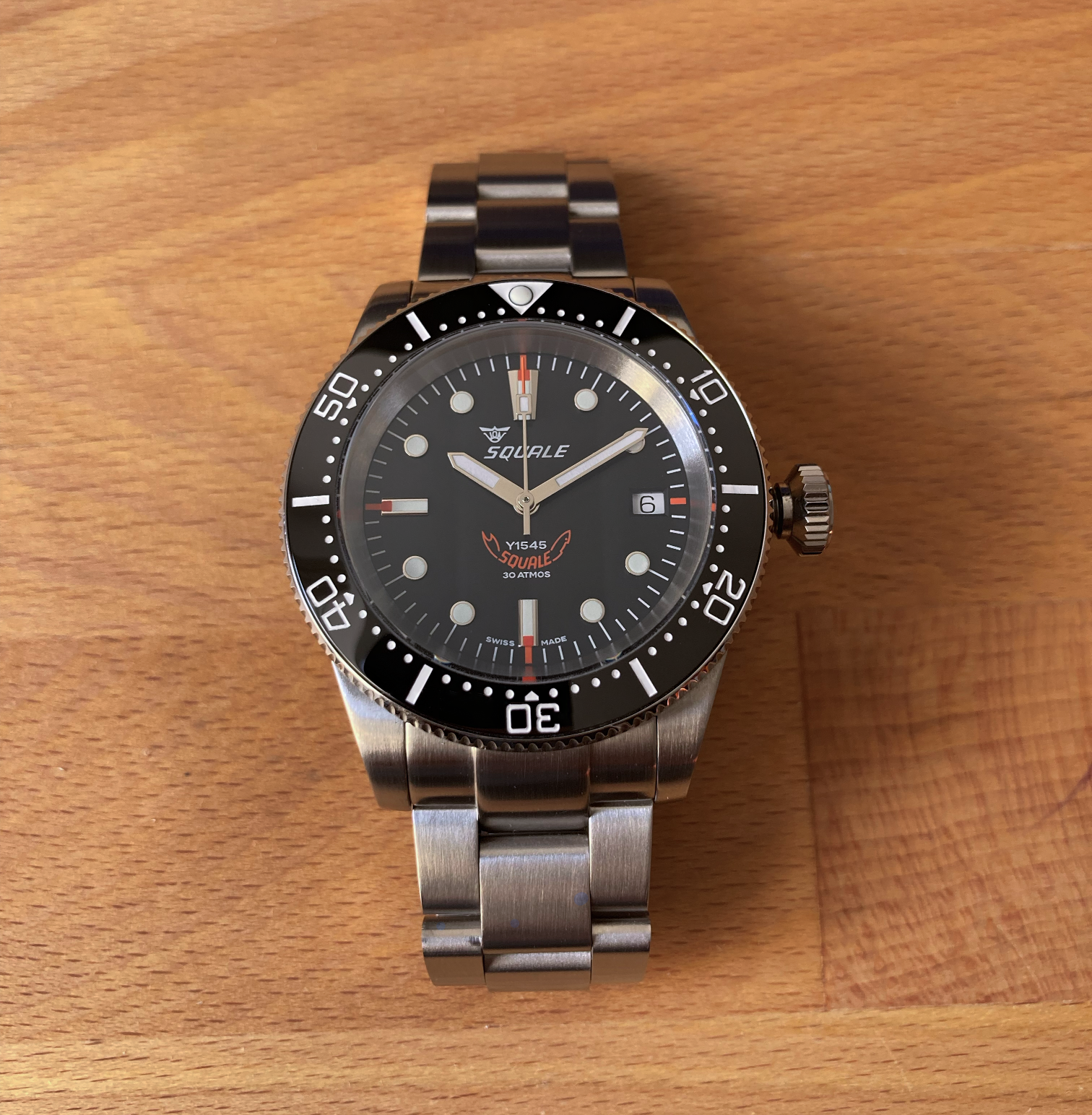
The history of dive watches is fascinating. The earliest ones were the Blancpain Fifty-Fathoms, the Rolex Submariner and the Zodiac Seawolf, all of which came out in the early 50s. It was a time when watchmakers competed to produce the most technically capable watch that could be submerged to increasingly lower depths, where they would be subjected to higher pressure. There was military interest too and companies like like Doxa, Omega, Rolex, Bulova and Longines were pushing their designs into uncharted waters. If you're interested in the history, I would recommend Watch Chronicler's three-part video series on YouTube.
Some lesser-known brands like Mido, amongst the first to design a cork-crown water sealing system in the 30s; Squale (or von Büren), who produced water-resistant cases for other brands as early as the 50s; and Certina, who developed their double-security (DS) system in 1959, also deserve special recognition.
The Rolex Submariner is notable for having managed to free itself from the confines of the aquatic world and go on to become one of, if not the most, iconic and emulated watch designs in the world. It even managed to become a luxury product despite its toolish characteristics.
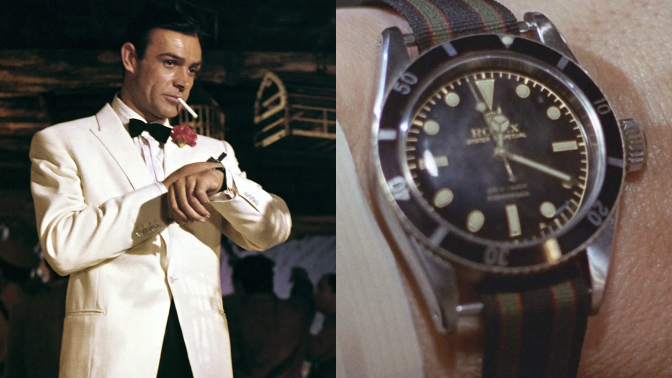
Today, dive watches are enjoyed more by "desk divers" like myself—people who only very occasionally go into water (and usually in a swimming pool) but wear dive watches for their design—than actual divers. But over time I've come to realise that as useful as these watches were under water in the past, they are perhaps even more relevant and useful outside of it in our everyday lives. And yes, more than smart watches.
The timing bezel
The defining trait of a dive watch is the unidirectional rotating timing bezel. To understand why this is so useful, we have to first understand how it works.
The bezel will usually have a triangular marker with a luminous pip that, in its neutral position, will be at 12 o'clock. Here, it's simply a minute marker. In the following photo, the hour hand is at the 10 o'clock and the minutes hand is clearly at 8, which makes it easier to read the time as either 10h 08 or 22h 08.
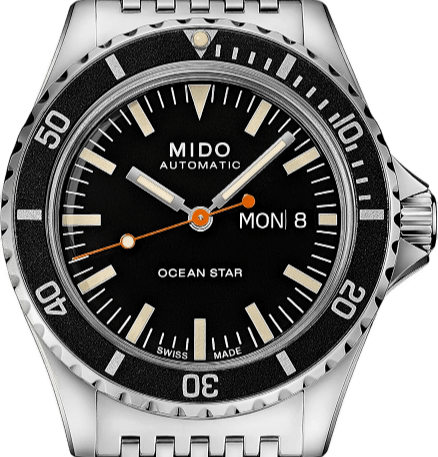
But the bezel is not static. You can rotate it to time things. We'll take an everyday, non-diving activity as an example: cooking pasta.
Say I'm making some amatriciana and my packet of spaghetti indicates a 9-minute cooking time to al dente. Generally, this means that I will boil the pasta in a pot of salted water for about 7 minutes and finish it in a tossing pan with the guanciale-tomato sauce for about 2 more minutes. So I need to time for 9 minutes split into 7 + 2, roughly. There are two ways to do this with a timing bezel: in time-elapsed or countdown timer mode.
Time-elapsed mode
To use my watch as a time-elapsed timer, I will rotate the bezel to align the marker with where the minute hand currently is right after I put my pasta in boiling water.
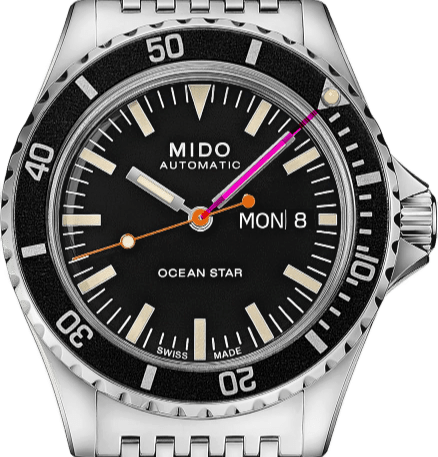
From then on, the markings on the bezel represent the minutes elapsed. Once the minute hand reaches 7 on the bezel, I will transfer the pasta to the pan where I'll be preparing the sauce. I will continue cooking and tossing the pasta (mantecare) in the pan till the minute hand is around at around 9 on the bezel, at which point the pasta is ready and I can serve it.

Countdown timer mode
There's another way to do this. In countdown timer mode, I will rotate the bezel, just after I put the pasta in boiling water, to where the minutes hand will be 7 minutes from now.
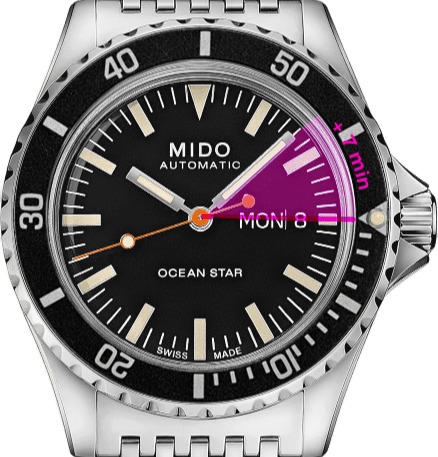
As the pasta boils and the minutes tick away, I can see it slowly approaching this marked point. I can tell at a quick glance if I'm a at half-way point, which is useful to time my sauce preparation.
When the hand reaches the triangle, I'll know that my 7 minutes have passed and that I need to transfer the pasta to the pan. As I do so, the minute hand goes past the marker and the watch is now automatically in time-elapsed mode. I will now finish the pasta in the pan till around when the minute hand reaches 2 on the bezel. I've timed 9 minutes but with a marker in between, with just one initial manipulation.
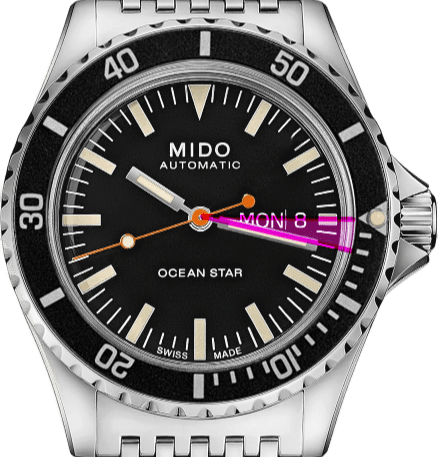
Unidirectional
You'll notice you can generally only rotate the bezel in one-direction, counter-clockwise.
This is a safety feature for its original intended use of diving timer. Imagine you align the bezel to the minutes hand before going in for a dive, and you know that your bottom time is 15 minutes max. You dive in and monitor the watch from time to time to make sure you don't go over the 15 min mark. Because you can only turn the bezel in the counter-clockwise direction, if you do accidentally turn the bezel, it will only indicate less available time and never more. This is because you can only move the triangle on the bezel bezel earlier in time, never later. If you do accidentally manage to roate it underwater, you will err on the side of being more careful and thinking more time has passed than it really has.
The uni-directional bezel is not the only variety that exists, however. There are bezels that can be locked with a special mechanism so that no such accidental rotation is even possible at all, like in the Yema Superman or the Squale Tiger. There are also bezels that are specifically designed for counting down, where the numbers at 60 and decrease as you move clockwise. With this, you set the bezel marker to a specific time and the bezel will then tell you how many minutes are left to reach it.
Track hours
"But Félix," I hear you say. "You can only use these to time up to 60 minutes, then?"
Well, yes and no. If you're tracking minutes, it is indeed limited to 60 minute blocks, but this can often be enough since you generally know if an hour has passed or not. So you can track 30 minutes or an hour and 30 minutes (60+30) minutes just as easily.
However, you can also use it to track hours. Instead of liming up the bezel with the minutes hand, simply align it with the hour hand. The bezel is then tracking hours instead of minutes. Sure, the numbers on the bezel are less useful (although you could mentally divide them by 5 to get the correct hours elapsed), but you can just as easily see how many hour markers the hour hand has traversed from the original position.I personally use this typically when I'm slow-cooking something, or right before I go to sleep.
In fact, there are even dive watches made specifically for tracking hours; the Blancpain Fifty Fathoms "Bund" edition, made for the German Bundeswehr (and for which Squale made the case), doesn't have minute markings on the bezel precisely for this reason.
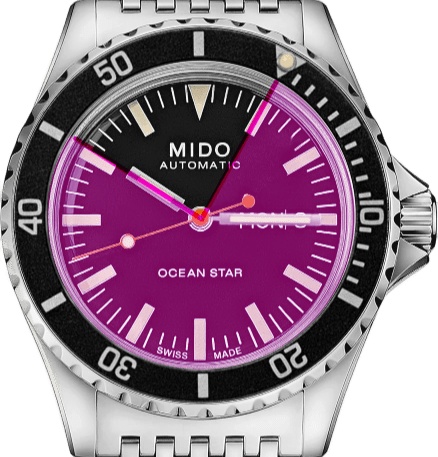
In the image above, you can see that I started tracking hours elapsed at around 1 h, right before I went to sleep. When I woke up, it was about 10 h. The diving bezel shows that I've been in bed for about nine hours.
Why not just use a stopwatch?
There is another watch complication that is specifically designed to time things: the chronograph, or as most people call it, a stopwatch. You could use that too and it is useful but in my opinion, not as versatile. A stopwatch is extremely precise–you can often time things down to seconds, milliseconds and even centiseconds (¹⁄₁₀₀th of a second).
But what you gain in precision, you lose in usability, because a stopwatch measures time in a separate timeline.
You see, a stopwatch starts a timer from zero in a different, parallel timeline to the one you're in. Even visually, the stopwatch is often either a separate mode in a digital display that one has to first engage with a few button presses—not ideal when cooking—or a completely separate dial on an analog watch. It can tell you 5 minutes 30 seconds and ³³⁄₁₀₀th of a second have elapsed but but it won't show how that relates to the current time. This makes sense for its intended use—timing races, air navigation or scientific experiments, where precision is very important—but not for everyday situations that don't require that level of precision.
With a timing bezel, timing happens within the same timeline, relative to current time. If you started timing at 19h 38, and when you check a bit later and the timing bezel says that 7 minutes have passed, the dive watch also tells you that this corresponds to 19h 45. With one look at the bezel, you can also easily tell that when it'll be 20h, approximately 20 minutes will have passed. In some ways, setting the timing bezel like placing a temporal marker in your current timeline. It's like leaving a bookmark on a certain page as you continue reading the book versus writing down the page number in a completely separate piece of paper.
How I use it
I use my timing bezel everyday, sometimes multiple times a day. Here are some examples of how:
- Cooking: We've been through this one. I don't need precision timing but do need to keep an eye on when I started a particular step in a multi-step preparation.
- Walking: Before I set of on a walk to somewhere, I'll often check how long I expect it to take me. I then use my watch as a timer so it gives me a visual indication of where I am in the walk relative to, say, the 45 min estimate. Often I'll also have looked up around where I should be around the 50% mark and see if I'm walking faster or slower than planned (in other words, if that first half has taken more or less than 23 minutes).
- Morning coffee: I don't drink coffee until at least 20 minutes after I've brushed my teeth in the morning. I align the bezel with the minutes hand when I'm done brushing so I know when 20 minutes have passed. I genuinely do this every morning since I don't always wake up at the same exact time.
- Marking a departure time based on estimated travel time: If I need to get to a particular place at say 15 h and I know it takes 45 minutes, I can align the 45 marker on the bezel to 15 h on the dial and the pip will now indicate the latest time I need to leave the house to be on time. As I go about my business, I can keep an eye on that leave-home-by time to make sure I don't go over it.
- Cycling: For longer rides (over 50 km), I stop for a snack or a drink about every 45 min to an hour. I reset the timing bezel after every stop so I can always tell at a glace of where I am now relative to my last stop.
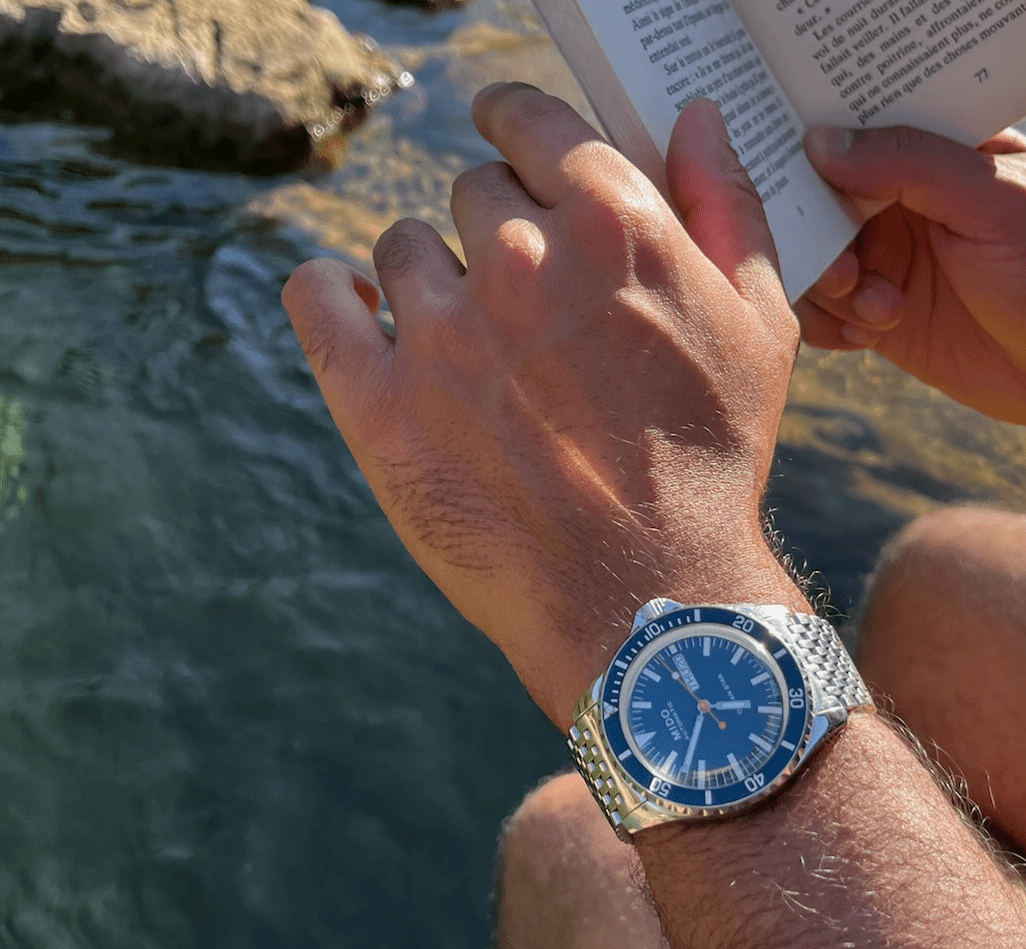
Getting a dive watch
If I've managed to interest you in dive watches and you've started to research your options, you might find it all a bit overwhelming. The world of watches can be quite a rabbit hole, with a whole lot of criteria that sound important: movement, bezel material, luminescence, brand heritage, case material, date complication, bezel material, applied or painted indices, case size and of course, cost.
If you're just starting out, I would recommend quartz-based watches like the Seiko SNE series, or the Glycine Combat Sub Sport. These are not just more affordable than mechanical watches but also more reliable and accurate, and will likely last a very long time indeed. The Seiko one is even solar-powered so you won't have to worry about frequent battery changes. They can both be found for much lower than their retail prices online
If you absolutely want a mechanical dive watch, you can consider the Citizen Promaster series (including the titanium Fujitsubo one), Orient divers or the Seiko SPB series. If a Swiss movement is what you're after, consider Tissot, Certina, Mido or Squale. For something higher-tier, I recommend watching Watchfinder & Co's video on YouTube for a comprehensive overview.
If I've not managed to convince you of the utility of dive watch, I nevertheless hope you've enjoyed this little éloge to this humble tool with a rich history.
